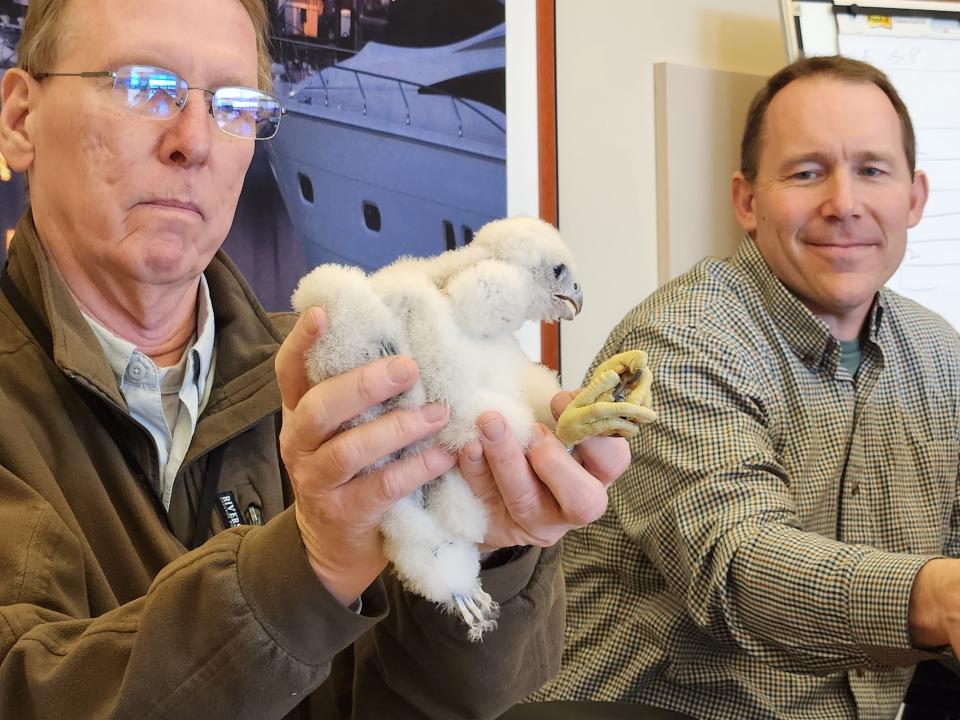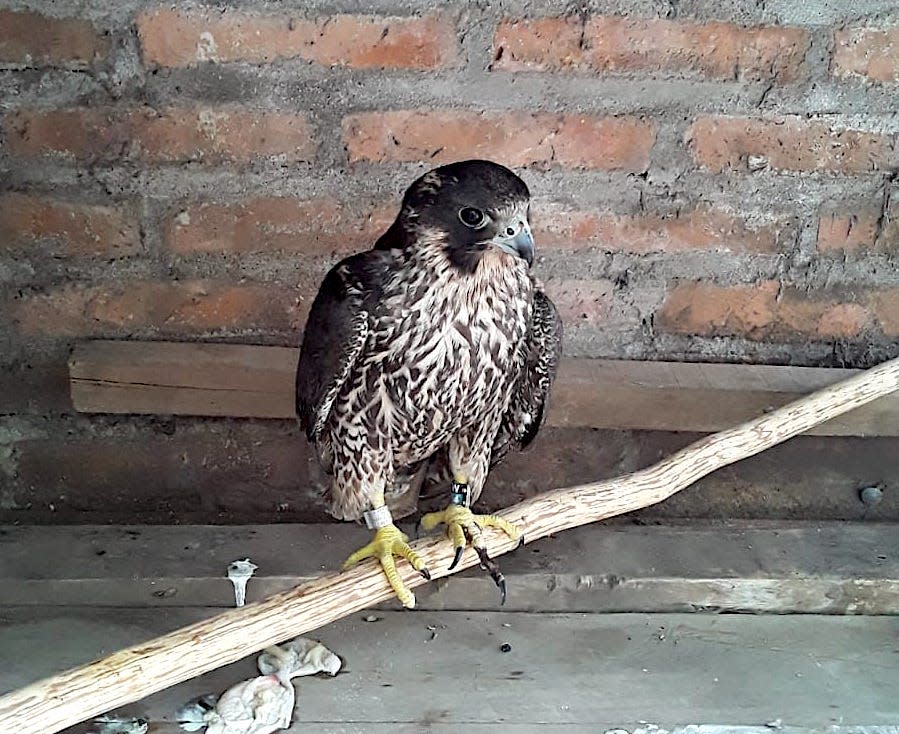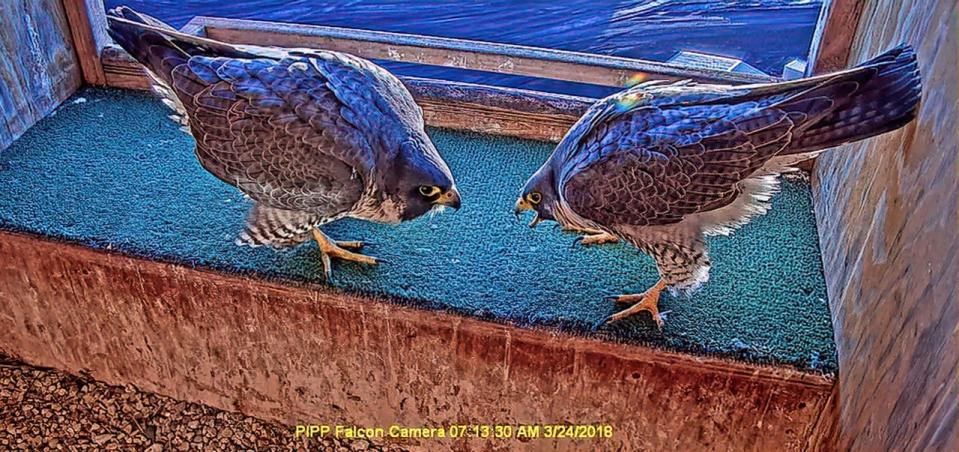Smith: Peregrine hatched in Port Washington and found 2,100 miles away shows why the species is called the wanderer
Peregrine falcons are well-known as birds of prey that can fly extremely fast and travel long distances.
Peregrines have been timed in stoops, or steep dives, at speeds of 200 miles per hour, according to the Cornell Lab of Ornithology.
And the species Latin scientific name Falco peregrinus translates to "wanderer" in English. The bird is found on all continents except Antarctica.
More: Outdoors calendar
So there's not much that surprises peregrine expert Greg Septon of Franklin when it comes to this bird that can fly as fast as an Indy car and travel the globe.
But with experience handling and banding 1,420 peregrines since 1986 when he founded the Wisconsin Peregrine Falcon Recovery Project, Septon has also learned to expect the unexpected.
Early 2024 delivered just such a surprise gift.
It's contained in the tale of "Pete," a female peregrine hatched and fledged in 2023 from a nest box at the We Energies plant in Port Washington.
And it helps highlight the value of not only the continued recovery effort for peregrines, listed as an endangered species in Wisconsin, but also of the meticulous records kept as part of the project's bird banding work.

Pete was named for Carroll University’s mascot Pio Pete. As protocol for the approximately 40 nests Septon monitors each year, he plucked the nestling for a brief handling session. Blood was taken from the bird for testing and identification bands were attached to its legs.
In Pete's case, the bands were black over blue with the code W54.
The bird was then returned to its nest to grow and live in the wild. Septon knew Pete successfully fledged, or flew from the nest, last year.
But after that the bird's whereabouts were a mystery. Was it in southeastern Wisconsin, a relative stronghold for the species? Did it travel in the region? Or was it a bird intent on living up to its Latin name?
Peregrines are fascinating for many reasons, Septon said, including the wide range of their behaviors. The species is able to live in Milwaukee year-round, for example. But some choose to migrate long distances.
"We don't know why," Septon said. "It's part of the mystique of the species. Why go through the rigor of migrating thousands of miles to another locale when you can stay in your home territory when you have all the food you need at home?"
While some birds are photographed or viewed locally and reported to Septon, Pete's whereabouts were unknown after fledging last summer in Port Washington.
Until last month, that is.

And the report answered the question about what type of peregrine Pete chose to be.
On December 9 a resident of Sebaco, Nicaragua, observed two crested caracaras harassing a peregrine falcon. Sebaco is about 45 miles north of Managua in the northwestern portion of Nicaragua.
The falcon was grounded and unable to fly. So Missael Sotelo Rizo picked up the bird and brought it home to care for it.
He fed the bird for two weeks until it was fit for release.
He also noted the identifications on the bird's bands. After Sotelo Rizo entered the band information with the federal Bird Banding Laboratory, Septon was notified of Pete's location.
Although he had no prior experience helping injured birds, Sotelo Rizo said he wouldn’t hesitate to do it all over again.
“I felt great satisfaction seeing how she was flying again,” he said in a statement issued by We Energies. “I made sure to release her in a wooded area away from people who might hurt her.”
Septon estimated Pete traveled a minimum of 2,100 miles from Port Washington to Nicaragua.
The story has another interesting angle. We Energies employee and Carroll University graduate Mike Grisar helped band Pete last year. The bird has added a new dimension to the university's Pioneer nickname and made Grisar an especially proud alum.
What's next for Pete?
Septon said it was apparent from photographs that the bird had an injury to the middle toe on its left foot.
"But raptors can often survive and do well after losing a toe so we’re hopeful “Pete” will return north and that we’ll see her again at some point," he said.

Septon said Pete was not the only peregrine produced last year reported outside of Wisconsin.
A bird named Iggy after Marquette University’s mascot was recently spotted in Indiana. It was also produced in 2023 at a We Energies facility (the Valley Power Plant in Milwaukee).
And in the history of the state peregrine recovery, one bird (a male produced from a nest in Menasha) was documented traveling farther than Pete. Septon said that bird flew about 2,500 miles to Venezuela.
In 2023 Septon monitored 43 Wisconsin peregrine nest sites that produced 125 young. Power plants such as We Energies sites have proven to be valuable for the species; last year peregrine nests at 10 power plants produced 28 young, or 22% of the state total.
Septon is preparing for another year leading the state's peregrine recovery project. The birds are currently pairing up and exhibiting courtship behaviors. Nesting will start in the coming weeks.
"We don't know how many young we'll get or where any of them will end up," Septon said. "But as in the case with Pete, we'll always be ready for anything."
This article originally appeared on Milwaukee Journal Sentinel: Peregrine falcon hatched in Port Washington found in Nicaragua

